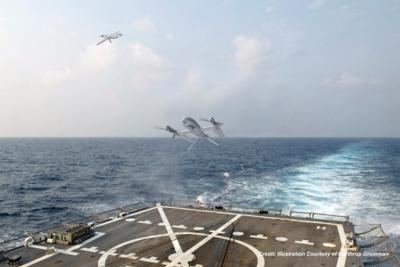Sun, Jul 30, 2023
Northrop Grumman Contracted for Next-Gen Seaborne VTOL UAV Beyond Current Market Capability
The Defense Advanced Research Project Agency’s (DARPA) Tactical Technology Office has contracted with Northrop Grumman to design an autonomous VTOL aircraft system for use in US Navy ships while underway, slated to carry a 60-lb payload for more than 20 hours of flight time.

The contract illustrates the relatively empty field in that particular tactical niche, one that has been addressed through more traditionally designed, helicopter-like UAVs abroad. Naval aviation is often a difficult realm of design and operations, combining a moving takeoff and landing platform with the fueling constraints of operations beyond convenient, abundant supply lines - and that's leaving out the harsh impacts of landing in rough seas. While General Atomics has made some headway in adapting its existing MQ-9 platform to oceanic operations, their mods basically amount to a STOL kit for improved takeoff performance on carriers. The Schiebel Camcopter S-100 has seen increasing use overseas, but its wankel engine limits endurance to a bit more than 6 hours with a 75-lb payload, making fall short of the 20-hour contract requirement.
Grumman hopes its AdvaNced airCraft Infrastructure-Less Launch And RecoverY (or, in typical MIL fashion, "ANCILLARY") demonstrator will fit the bill as a "cost-efficient, multiple-mission capable vehicle built on an agile platform that is runway independent." It believes the Ancillary platform will be "capable of carrying a large 60-pound sensor payload with greater endurance of 20 hours’ time on station and mission radius range of 100 nautical miles", while noting that such specs exceed current systems. Additional goals include the ability to land in adverse weather conditions. Its mission will be the usual blend of ISR, targeting, and expeditionary support one would expect of a little whirlybird at sea, as they've all been since the original U-Boat rotor kites took to the skies in WWII. Of course, the new equipment will be far more effective, but it's interesting to note that the tactical lineage is there - ships want a pair of eyes they can launch themselves.
Northrop Grumman VP of research and advanced design Tim Frei made sure to weigh in on the situation with a generically encouraging pull quote, saying the firm will work with DARPA "to significantly enhance how future autonomous vertical lift aircraft will operate at sea and ashore. The ANCILLARY program enables us to combine our digital engineering expertise with extensive knowledge and insights from past successes in developing and operating uncrewed vertical lift aircraft for the U.S. Navy.”
More News
Secondary Radar/Radar Beacon (ATCRBS) A radar system in which the object to be detected is fitted with cooperative equipment in the form of a radio receiver/transmitter (transponde>[...]
Aero Linx: Australian Society of Air Safety Investigators (ASASI) The Australian Society of Air Safety Investigators (ASASI) was formed in 1978 after an inaugural meeting held in M>[...]
Make Sure You NEVER Miss A New Story From Aero-News Network Do you ever feel like you never see posts from a certain person or page on Facebook or Instagram? Here’s how you c>[...]
From 2023 (YouTube Edition): Barking up the Right Tree Australian-born, the Aeropup is a remarkably robust, fully-customizable, go-anywhere, two-seat, STOL/LSA aircraft. The machin>[...]
Also: New Amelia Search, B737 Flap Falls Off, SUN ‘n FUN Unveiling, F-16 Record Captain Sully Sullenberger, the pilot who saved 155 people by safely landing an A320 in the Hu>[...]
 ANN's Daily Aero-Term (07.12.25): Secondary Radar/Radar Beacon (ATCRBS)
ANN's Daily Aero-Term (07.12.25): Secondary Radar/Radar Beacon (ATCRBS) ANN's Daily Aero-Linx (07.12.25)
ANN's Daily Aero-Linx (07.12.25) ANN FAQ: Turn On Post Notifications
ANN FAQ: Turn On Post Notifications Classic Aero-TV: Of the Aeropup and its Pedigree
Classic Aero-TV: Of the Aeropup and its Pedigree Airborne 07.07.25: Sully v Bedford, RAF Vandalism, Discovery Moving?
Airborne 07.07.25: Sully v Bedford, RAF Vandalism, Discovery Moving?



